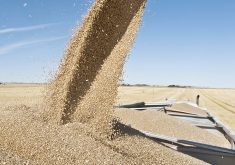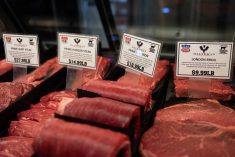The Loonie has suffered less than the euro, which has dropped by nearly three per cent since the U.S. election
The U.S. greenback has been on a tear since the election, with the nearby U.S. dollar index trading just over 106 points. This represents a three per cent gain in the U.S. dollar since pre-election lows.
The dollar index is a trade-weighted basket of currencies and gives an indication of the strength of the U.S. dollar relative to trading counterparts.
Given the proposed tariff policy of the new U.S. administration, it makes sense that the trade would sell trading partner currencies and buy the greenback.
Read Also

Organic farmers urged to make better use of trade deals
Organic growers should be singing CUSMA’s praises, according to the Canadian Chamber of Commerce.
One would think the Canadian dollar has seen the largest impact of the major trading partners, but the loonie has suffered less than the euro, which has dropped by nearly three per cent since the election.
The Canadian dollar has lost close to 1.4 per cent since November, with the nearby contract trading below the 71.5 U.S. cent level. The loonie is trading at its lowest since May 2020.
How low can the loonie go? It is likely to test the 70 U.S. cent level in coming months and may even test the 68 U.S. cent level, which corresponds to the 2020 and 2016 lows. Given divergence between the U.S. and Canadian economies, there is no reason the loonie can’t trade below the 70-cent level for a significant period.
Canadian farmers should be prepared for currency turbulence in the next few years, and it is hard to foresee events that would cause the loonie to rally. On the positive side, farm gate returns for some should increase.
This gain will be at least partially offset by input costs that are mostly U.S.-dollar related. The next market moving information for the loonie will likely occur when the Bank of Canada announces its next interest rate change Dec. 11. The market expects another interest rate reduction of at least 25 basis points.
Complicating the price picture for Canadian farmers is that the dollar is only one factor in price determination. Commodities are generally adjusting to the strong U.S. dollar by dropping futures values to offset the strong dollar.
There is also a broad selloff in commodities due to a bearish attitude for the sector by funds in general.
A slowing global economy, especially in China, is the main driver of this trade. Crude oil is the chief commodity in funds’ crosshairs, but there has also been pressure across the agricultural sector. Of chief concern are soybeans, which are vulnerable to a U.S. trade war with China.
Other agricultural commodities have also been caught up in negative sentiment for slowing global economic growth. Canola, wheat, corn and soybeans have seen a significant sell off in prices since the U.S. election.
The bad news for farmers is that any currency gains may be offset by declining prices. Sometimes you can’t win for losing.















